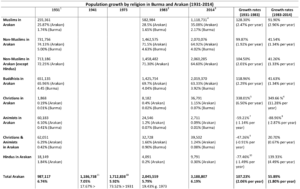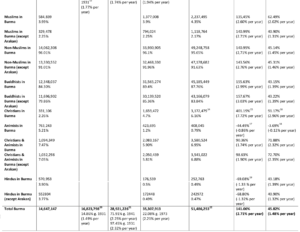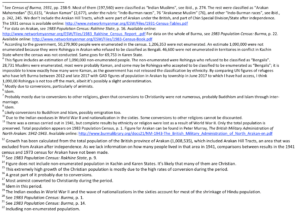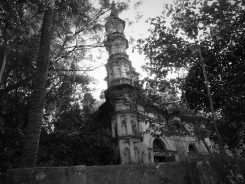‘Illegal migration’ in Arakan: myths and numbers - New Mandala (original) (raw)
One of the rationales underlying the persecution of the Rohingya by the Burmese state is that they are “illegal immigrants from Bangladesh”, having flooded Rakhine State (formerly known, and referred to here, as Arakan State) over the last century. But how valid are such claims in the face of available evidence?
The border between Bangladesh and Burma is extremely porous and has been poorly guarded on both sides for long stretches of time; smuggling of all kind of goods, including narcotics, is a common feature there, and often happens with the connivance of corrupt officials. Moreover, the grip of the Burmese state in border areas is very tenuous, and Northern Arakan is no exception.
Nobody, however, has provided any evidence of massive waves of “illegal Bengalis”. Nevertheless, the government and institutions linked to it have repeated such claims over and over again, and they are believed by many Burmese. In 1965, Ne Win visited Pakistan, and the West German ambassador reported that discussions took place about “the problem of the roughly 250,000 Moslems resident in the Province of Arakan whose nationality is unclarified because the Burmese regime regards them as illegal immigrants from East Pakistan.” This figure was literally doubled in a paper published as recently as 2018 by the Myanmar Institute of Strategic and International Studies (Myanmar-ISIS), a government think tank founded in 1992 by the military junta then ruling the country. The paper asserts that “in 1971, there were around half a million war refugees who fled into Myanmar […] to escape the violence of the Bangladeshi war of independence.”
Myanmar-ISIS gives two sources for such an extraordinary assertion: a book written by Moshe Yegar, a former Israeli diplomat, and a conversation that the British and Bangladeshi ambassadors in Rangoon maintained in 1975, as recounted by the British diplomat. But Moshe Yegar merely wrote that “an undetermined number of Bengalis who were opposed to the cessation of Bangladesh from Pakistan fled to Arakan. Subsequently almost 17,000 Bengalis returned though the number that remained in Arakan continues to be unknown.” And in the conversation between the two diplomats, the British ambassador recounts that his Bangladeshi counterpart “admitted that there were upward of ½ million Bangalee [sic] trespassers in Arakan whom the Burmese had some right to eject”. The problem is that nowhere is given give any indication of what the Bangladeshi diplomat meant by “Bangalee trespassers”.
In a context in which young modern nation-states had been built on the basis of ethno-religious identities—as it was the case of the partition on India and Pakistan and the subsequent partition between West Pakistan and East Pakistan which generated Bangladesh—the Bangladeshi ambassador could have meant that the “Bengalis” didn’t belong to Arakan State as a consequence of their ethno-religious identity: in short, that many of them had trespassed during colonial times. There is no reason to believe he meant that half a million Bengalis migrated to Arakan after Burmese independence, let alone after the Liberation War of Bangladesh in 1971. And whatever he meant, there is no reason to believe that he was right. His credibility is seriously put in doubt by no other than the British ambassador himself, who at the end of the report asserts: “I do not regard [the Bangladeshi ambassador] Mr Kaiser as an entirely reliable source of evidence. I have found his views in the past highly subjective and sensational.”
Such is the flimsy “evidence” for the invasion of “illegal immigrants” narrative. It is important to recall here that, in the strict sense, “illegal immigration” only refers to such migration that may have occurred after Burma attained independence in 1948. According to colonial laws, migration from any part of India to Burma was perfectly legal. And no law enacted after independence by the Burmese government, not even the infamous 1982 Citizenship Law, has made immigration during the colonial period retroactively illegal. Therefore, I will focus on the period after independence, not on the heated debate on the term “Rohingya”, as I have done already in New Mandala, or migration waves during colonial times.
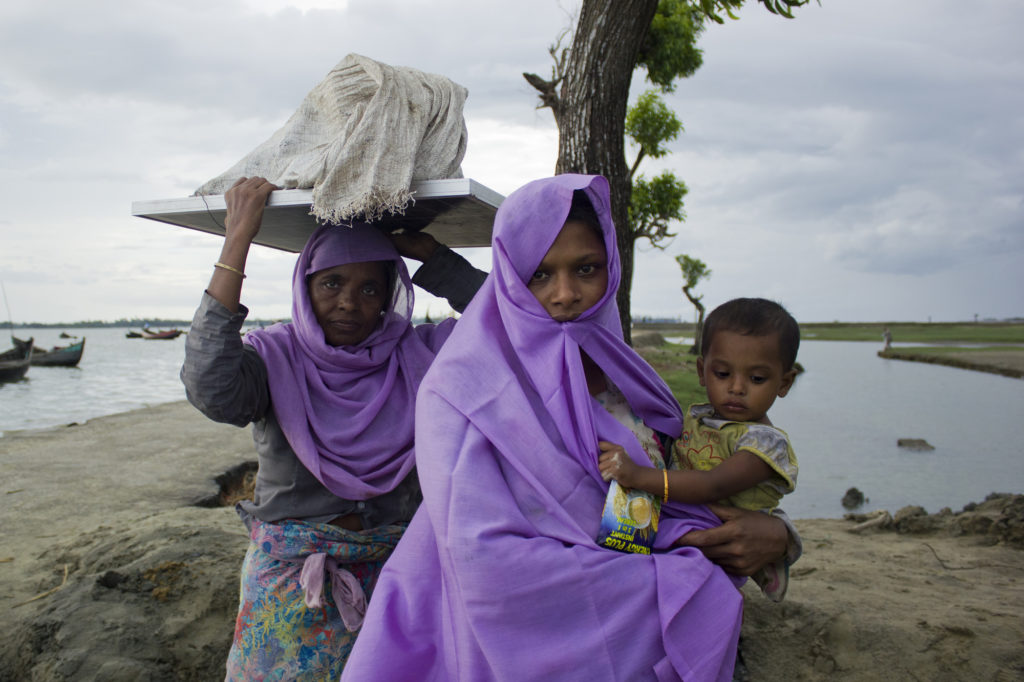
ROHINGYA REFUGEES, BANGLADESH, 2017 (PHOTO: AUTHOR)
What census data suggest
In order to ascertain the extent of “illegal immigration” from East Pakistan/Bangladesh, we need to take a look at censuses. A comparison between the 1931 census, the last conducted by the British in Burma whose full results have been preserved, and the 1983 and 2014 censuses, carried out by the Burmese government, should throw some light on the question. It is a task complicated by the fact that the ethnic, and national categories employed in these censuses are far from consistent. Comparing ethnic categories is almost impossible, given how arbitrary such classifications were both under the colonial period and after independence. For instance, in the 1983 Census, most Muslims in Arakan were incongruously classified as “Bangladeshis”, that is, as citizens of a nation-state which at that time had only existed for 12 years.
The only category that has been kept constant throughout censuses is that of religion. Given that the overwhelming majority of Rohingyas are Muslims and that most Muslims in Arakan are Rohingya (Kaman Muslims account for a very tiny fraction of Muslims in all the censuses), we need to look at the growth of the Muslim population in those periods, with the caution that our conclusions can only possibly be approximations. But they can give us realistic orders of magnitude. I will divide our analysis in two periods: from 1931 to 1983 and from 1983 to 2014, as the late seventies and early eighties marked the beginning of the persecution of the Rohingya.
TABLE P1
TABLE P2
TABLE NOTES
As we can see in the table comparing different censuses [view PDF here], the demographic growth of the Muslim population between 1931 and 1983 in Arakan (128%) was higher than the growth among non-Muslims (99.9%) or any religious group in the state, albeit lower than the total for Burma (141%) and not much higher than that of the Buddhist population (119%), so it can’t be regarded as inordinately high.
It is interesting to note that the Christian population in Arakan grew much than any other (by 338%), albeit from an extremely low base of 1,868 Christians in 1931. Like in the rest of the country, such a high Christian growth rate is due to conversions, mostly of animists (the majority of them in Arakan would have been ethnic Chin, Mro or Daingnet). But the combined Christian and Animist population declined enormously in the state (with a negative growth of 59.2%), against the tendency in the rest of the country (in which it grew by a 98.7%). The key factor in such a decline, apart from emigration, must be conversions of animists to Islam and Buddhism, probably through intermarriage.
The Hindu population in Arakan, as well as in Burma as a whole, also declined during the period 1931–1983. That was mostly due to the Indian exodus during World War II, when up to half a million Indians fled Burma, and during the nationalisations of Ne Win during the mid-1960s, when around 300,000 left. Some conversions to other faiths cannot be discounted.
To play the devil’s advocate, in ascertaining how many Muslims in Arakan may be “illegal” we can make a projection of growth for the Muslim population according to the growth of the non-Muslim population in the state except the Hindu population (as it shrank considerably due to specific factors) That rate was 104.5%. If such had been the growth rate among the Muslim population, there would have been 522,213 Muslims in 1983 instead of 582,984. Therefore, to continue the thought experiment, we could say that by 1983 there was a “surplus population” of 60,771 Muslims, amounting to 10.4% of the total Muslim population.
But that doesn’t mean that 10.4% of Muslims enumerated in Arakan in 1983 were “illegal immigrants”. Many surely migrated to the state in the ten years between 1931 and the beginning of World War II, when it was still legal to do so. During that period, it was easier than after independence, as there was not an international border, however poorly guarded, as well as much less risky, given that there was no serious conflict in Arakan during those years.
We have no detailed records of Arakan, or Burma for that matter, from the census conducted in 1941, as these were lost as a consequence of the war, but according to the available data, growth in Arakan was higher than in Burma as a whole between 1931 and 1941. Some of it would have been due to immigration from the Chittagong region in Bengal, following a decades-long pattern. Also, we lack information about birth rates among the Muslim and Buddhist communities of Arakan during the period between the 1931 and 1983 censuses, but a higher birth rate among Muslims is very likely. According to the 1983 Census, Arakan State had the highest gross fertility rate in the whole of Burma, with an average of 3.2 children per woman. In all likelihood, the Muslim Rohingya community contributed to that.
Another likely factor contributing to the difference in growth rates between Muslims and non-Muslims in Arakan is a possibly slightly higher rate of internal migration from Arakan to more economically promising urban centres like Rangoon among the Rakhine Buddhist community. Internal migration was often more difficult for Muslims, as immigration authorities had imposed some restrictions of movement on Muslims in Northern Arakan as early as the 1950s. Conversions to Islam through intermarriage cannot be ruled out either, as we have already mentioned.
Given the available data, we can’t deny forcefully that there was some “illegal immigration” from Chittagong to Arakan after independence, but we can conclude that it would have been of a much smaller order of magnitude than that claimed by government sources and Rakhine and Burmese nationalists. Taking all the mentioned factors that would account for a higher growth among Muslims, I would venture that post-independence immigrants couldn’t have surpassed 5% of the total Muslim population of Arakan in 1983, or 1.4% of the total there (that is, around 30,000 people), and it is possible that the real figure was lower.
So to claim that half a million, or even a quarter of a million, of “Bengali illegal immigrants” entered Arakan after independence is a ludicrous exaggeration that contradicts any serious reading of the available data. In any case, as we have seen, there was much movement back and forth across the border during the period. For instance, thousands of Muslims fled to East Pakistan in the late 1940s and early 1950s as a consequence of the conflict between the mujahideens and the Burmese Army, and some “illegal immigrants” could be people among them—that is, simply returning to their lands they had occupied before independence. It is also important to remember that Operation Naga Min in 1978, when up to 200,000 Rohingyas fled to Bangladesh from brutal operations by the Army in search of “illegal immigrants”, did little to alter the demographic balance in the region, as the overwhelming majority of refugees returned after one year. And, whatever illegal immigration there may have been until that point, it was reduced significantly as a result of a more tight control of the border imposed from then on.
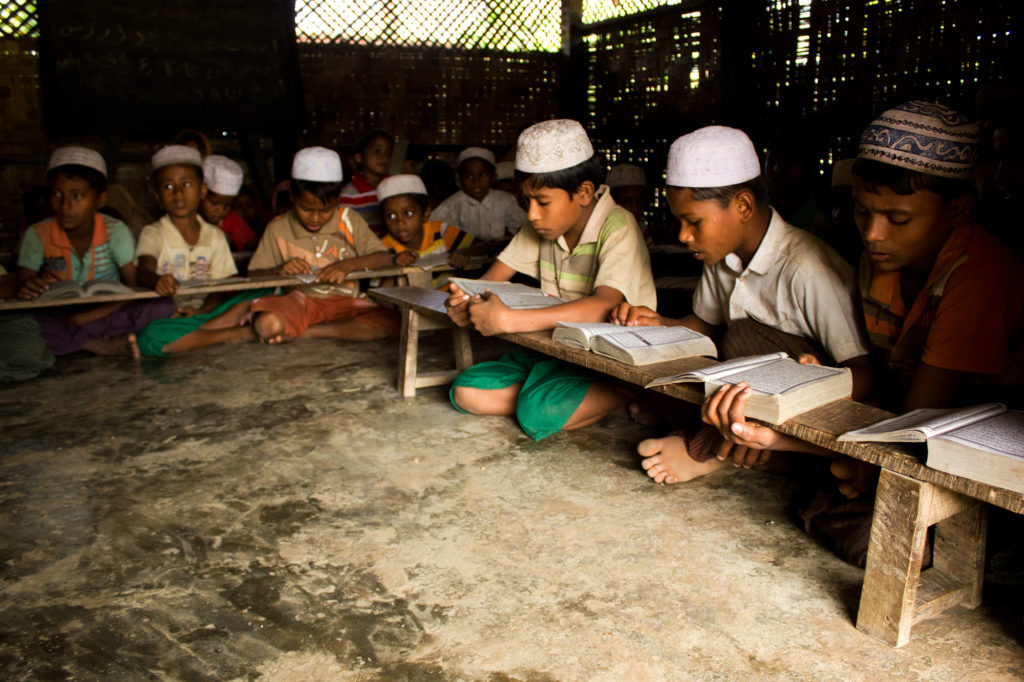
MAUNGDAW TOWNSHIP, 2016 (PHOTO: AUTHOR)
Effects of migration
The Burmese government started in earnest its persecution of the Rohingya population around 1978, beginning to subject them to an increasingly harsh regime of apartheid which has included an almost complete denial of access to education and healthcare services, unprecedented restrictions in their freedom of movement, even to nearby villages, and sporadic campaigns of violence. As a result, the Rohingya population has been largely confined to Northern Arakan and some pockets in central Arakan. In such circumstances, whatever illegal immigration that occurred since the late 1970s and early 1980s would have been offset by a larger flow of Rohingya fleeing the country.
Many Rohingya have fled poverty and oppression to countries like Bangladesh, Malaysia or Saudi Arabia. At the same time, many Rakhine have migrated to Malaysia or Thailand in search of economic opportunities denied at home. Also, against the idea of recent “illegal immigration” from Bangladesh, all relevant indicators reveal that, as impoverished as Bangladesh is, Burma is even more impoverished, and the gap widens in relation to Arakan, the second poorest state in the country. It would make very little sense for a Bangladeshi to seek a better life in a more impoverished region where he or she would be severely oppressed.
But the most astonishing finding in reading the census data is that growth rates among the Rohingya population in Arakan (whose demographic evolution, again, we are analysing through the category of Muslims in the censuses) are higher after policies of apartheid began to be imposed on them. If the growth rate between 1931 and 1983 was 2.47% per year, then between 1983 and 2014 it was 2.96% per year—higher than Myanmar as a whole (1.48% per year), Arakan (1.80% per year) or the Rakhine Buddhist population in that state (1.34% per year). The 2014 census revealed that the Myanmar population had grown much less than expected since 1983, due to lower birth rates and emigration to neighbouring countries. The Rohingya seem to be an exception. Why?
Part of the explanation is to be found in the containment of the Rohingya in certain areas during the period. Most Rohingya are blocked from migrating to other regions in Burma. Meanwhile the Rakhine enjoy freedom of movement, and many have moved to Rangoon and other places, including the Jade mines in Hpakant, in Kachin State, searching for more promising economic opportunities. As the results of the classification by ethnicity in 2014 census have not been released, it is impossible to know the exact number of Rakhine internal migrants living elsewhere in Burma. But it is probably high, and it would narrow the difference in growth rates between both communities. Nevertheless, such narrowing probably wouldn’t be very significant, as the growth rate of the Rohingya population is still much higher than the national rate.
Some Rakhine ultranationalists accuse the Rohingya of waging a “demographic jihad”, by begetting an inordinate number of children to overwhelm the Rakhine population and eventually take over the state. The idea that hundreds of thousands of people have decided to take part in a well-coordinated conspiracy to bear as many children as possible is absurd and doesn’t need any further analysis. But public officials have constantly exaggerated differences in demographic growths among the Rohingya, thus implicitly contributing to fuel the narrative of a “demographic jihad”.
For instance, in 2013 state officials gave the order to Muslims in Maungdaw and Buthidaung to not have more than two children. “The population growth of Rohingya Muslims is ten times higher than that of the Rakhine Buddhists. Overpopulation is one of the causes of tensions,” Win Myaing, Arakan State spokesman, said at the time. It was, of course, an exaggeration; the growth was about two times higher. And arguably it was not so much demographic growth among Rohingya what was causing tensions, but the constant repetition by local media, state officials, politicians of all stripes and Buddhist monks that such growth was dangerous.
The higher growth among Rohingya is not to be explained as some nefarious Islamist conspiracy or as a consequence of massive waves of “illegal immigrants” from Bangladesh. The most probable cause lies precisely in the conditions imposed on them by the government. It has often been shown that factors like poverty or lack of education are strongly related to high birth rates. Northern Arakan is one of the poorest regions of Burma and the Rohingya community have much less access to education than any other in the state and, probably, most of Myanmar as a whole. The grinding poverty in the Rohingya-majority areas, as well as the lack of education, the complete isolation from the rest of the country and the world, have arguably contributed to the high birth rates that the government decided to curtail. The irony is that the very same policies carried out over four decades by the Burmese state in its attempts to contain the Rohingya population have contributed to its demographic explosion.
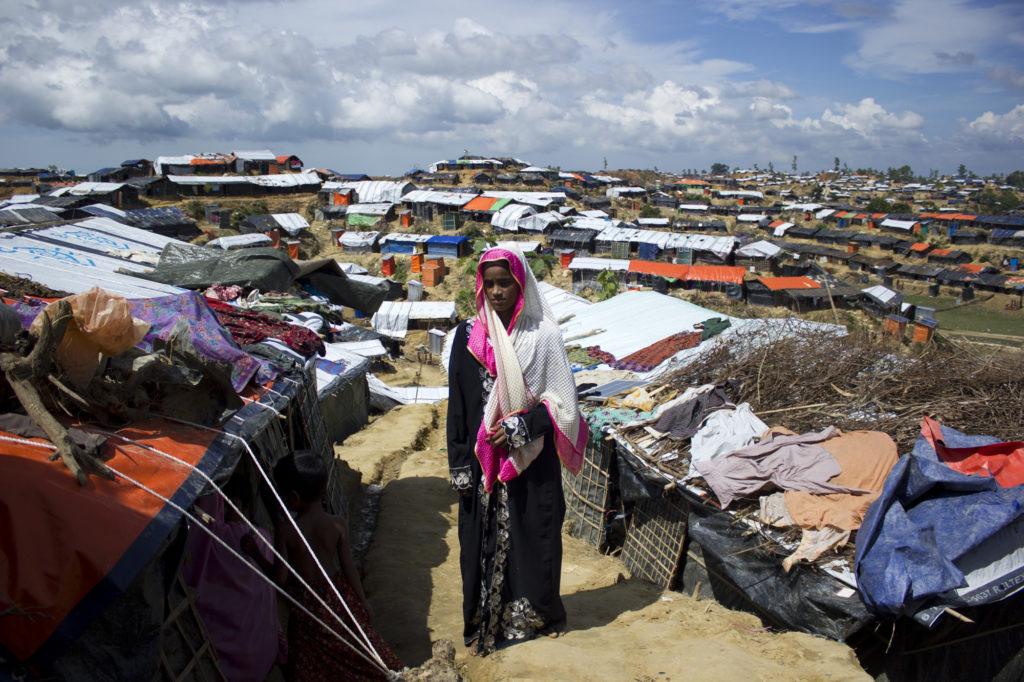
REFUGEE CAMP, BANGLADESH, 2017 (PHOTO: AUTHOR)
A dangerous delusion
In November 2015, Aung San Suu Kyi, asked about the accusations of genocide against the Rohingya during a press conference, said: “I think it’s very important that we should not exaggerate the problems in this country.” But that’s what most governments in Burma, including hers, have been doing regarding massive waves of “Bengali illegal immigrants” that only exist in their imagination, to exaggerate what in reality was a very small problem. This is not a phenomenon unique to Burma. Human beings everywhere tend to exaggerate the numbers of people they perceive as threatening for one reason or another. For instance, research conducted by the International Organization for Migration (IOM) in several European countries revealed in 2011 that their citizens believed that there were as many as three times the numbers of immigrants living in their countries that was actually the case.
A better political economy of the Rohingya crisis
Crude speculation about ‘land grabs’ obscures the complex historical roots of today’s Rohingya persecution.
By convincing themselves and the Burmese public that there was an invasion of “illegal Bengalis”, successive Burmese governments got a self-imposed “Rohingya problem” that would lead to apartheid, statelessness and ultimately to ethnic cleansing.[i] But the accusations of “illegal immigration” are probably just a smokescreen. It’s worthy to point out that Buddhists may have migrated from Bangladesh to Burma during the period as well. There were, and still are, Rakhine Buddhist communities in Cox’s Bazar and other regions in Bangladesh and Northeast India, some of whom call themselves Marma and many of whom trace their presence there to the period when Arakan was part of the Burmese kingdom in the late 18th and early 19th centuries.[ii] The state has treated them very differently to their Muslim counterparts, welcoming them with open arms, underscoring the fact that the issue is not “illegal immigration”, but an extremely narrow ethnonationalism. In reality, it is that exclusionary ethnonationalism which lies at the root of the self-imposed “Rohingya problem”, and not any imaginary invasion by “illegal immigrants”.
